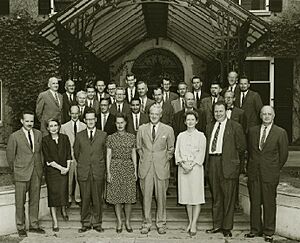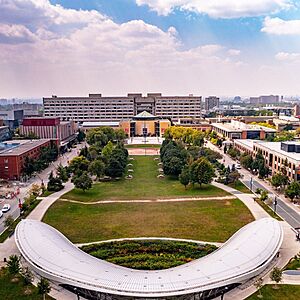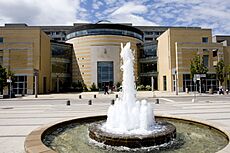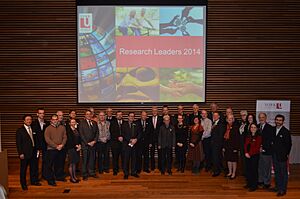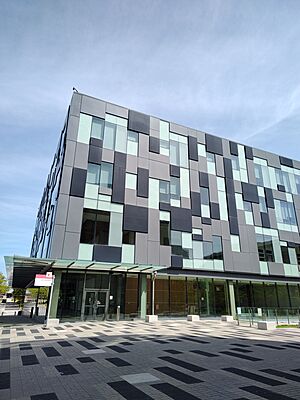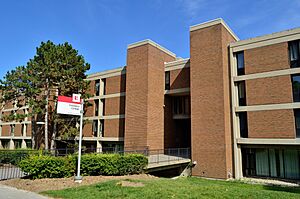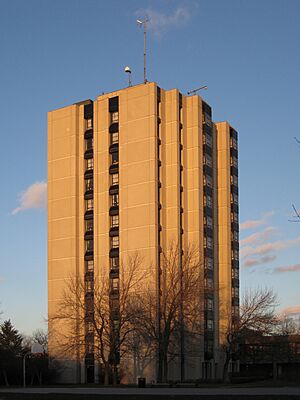York University facts for kids
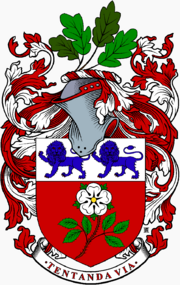
Coat of arms of the university
|
|||
|
Other name
|
YorkU | ||
|---|---|---|---|
| Motto | Tentanda via (Latin) | ||
|
Motto in English
|
The way must be tried | ||
| Type | Public research university | ||
| Established | 1959 | ||
|
Academic affiliations
|
CARL, COU, CUSID, Fields Institute, IAU, Universities Canada | ||
| Endowment | $615.0 million (2023) | ||
| Chancellor | Kathleen Taylor | ||
| President | Rhonda Lenton | ||
| Provost | David Peters (Interim) | ||
|
Administrative staff
|
7,000 | ||
| Students | 55,700 | ||
| Undergraduates | 49,700 | ||
| Postgraduates | 6,000 | ||
| Location |
,
Canada
43°46′23″N 79°30′13″W / 43.77306°N 79.50361°W |
||
| Campus | Urban / Suburban, 185 ha (460 acres) | ||
| Tagline | Right the Future | ||
| Colours | Red and White
|
||
| Nickname | York Lions | ||
|
Sporting affiliations
|
U Sports, OUA, Toronto Raptors | ||
| Mascot | Yeo the Lion | ||
 |
|||
York University (also known as YorkU or YU) is a large public university in Toronto, Ontario, Canada. It is the third-largest university in Canada. About 53,500 students attend York University. It also has 7,000 teachers and staff. Over 375,000 former students live all over the world.
York University has 11 main schools, called faculties. These include the Lassonde School of Engineering, Schulich School of Business, and Osgoode Hall Law School. It also has 32 research centers.
The university started in 1959. Its first classes were held in September 1960 with 76 students. They met at the University of Toronto campus. In 1961, York moved to its first own campus, Glendon Hall. This campus is now part of Glendon College. In 1965, a second, larger campus opened. This is the Keele Campus in North York.
Contents
Discovering York University's History
York University was officially created in 1959. This happened when the York University Act was approved on March 26, 1959. The first classes began in September 1960. They took place at the University of Toronto with 76 students.
In the 1960s, more universities were needed. People believed that higher education helped individuals and society. The university was set up with two main groups. One group, the senate, handled school rules. The other, the board of governors, managed money. The president connected these two groups.
In the fall of 1961, York moved to its first campus, Glendon College. Here, it focused on liberal arts and adult education. York became fully independent in 1965. Its main campus, the Keele Campus, opened in 1965.
Murray Ross was very important to York University. He was a vice-president at the University of Toronto. He helped York become a separate and strong university. Today, the Murray G. Ross (Valedictorian) Award honors him.
The Glendon campus became a bilingual school. It teaches in both English and French. Prime Minister Lester Pearson officially opened Glendon College in 1966.
York University started Canada's first dance program in 1970. In 1972, Canada Post even put York University on a stamp! The first PhD program in women's studies in Canada began at York in 1992.
The Keele Campus was once seen as far away. It was in an industrial area. Some early buildings had a brutalist style. Many people did not like the long distances between buildings. This was not good for the weather. Over the last 20 years, many new buildings have been added. These include a student center and buildings for fine arts and business. There is also a small shopping mall and a hockey arena. The Aviva Centre tennis stadium, built in 2004, hosts big tennis tournaments. York is now in a more central spot in the Greater Toronto Area.
In June 2014, York announced a new campus in Markham, Ontario. This campus was built with Seneca College. It opened for students in September 2024. It can hold about 4,200 students. It might grow to 10,000 students later.
Exploring York University Campuses
Keele Campus: The Main Hub
The Keele Campus is the largest campus of York University. It is in northern Toronto. Most of the university's schools are here. These include Liberal Arts, Business, Law, and Engineering. Nearly 50,000 students take classes at Keele. The York University station is a subway stop right on campus.
Glendon Campus: Bilingual Learning
Glendon College is a special campus of York University. It focuses on liberal arts and is bilingual. This means students can study in both English and French. The Leslie Frost library is located here.
Markham Campus: A New Location
York University opened a third campus in Markham in September 2024. The government of Ontario helped pay for its construction.
Other York University Locations
Some parts of the Schulich School of Business and Osgoode Hall Law School have offices in downtown Toronto. Schulich has the Miles S. Nadal Management Centre. Osgoode Hall has a Professional Development Centre.
The Faculty of Environmental and Urban Change has an eco-campus. It is next to the Las Nubes Forest Reserve in Costa Rica.
The Schulich School of Business also has a campus in Hyderabad, India. It works with the GMR School of Business.
In 2024, the government provided money to start the York University School of Medicine. It will be near the Cortellucci Vaughan Hospital in Vaughan. This will be the third medical school in the Greater Toronto Area. It plans to accept its first students in 2028.
Academics and Research at YorkU
York University has about 1500 full-time teachers and librarians. They are part of the York University Faculty Association. Other teachers and assistants are represented by CUPE Local 3903.
York University offers over 120 different programs for undergraduate students. They can earn 17 different types of degrees. There are also over 170 degree choices. Students can study abroad at more than 100 universities. International students from over 150 countries attend York.
University Rankings and Reputation
York University is recognized in many university rankings.
- In 2025, QS World University Rankings placed York 362nd in the world. It was 16th in Canada.
- The 2025 Times Higher Education World University Rankings ranked York 401–500 globally. It was 18th in Canada.
- In 2024, York was 35th globally for its work on sustainable development.
- The 2024 Academic Ranking of World Universities put York in the 401-500 group worldwide. It was tied for 17th in Canada.
- U.S. News & World Report Best Global University Ranking ranked York 466th globally in 2024–25. It was 17th in Canada.
- The Canadian magazine Maclean's ranked York University 4th among comprehensive universities in 2024.
These rankings show how well York University's research is known. They look at how often academic papers from York are mentioned by others.
York University also helps students find jobs after graduation. In 2022, QS ranked York 301–500 in the world for how well its graduates find jobs.
Faculties: Schools of Study
York University has 11 main faculties:
- School of Arts, Media, Performance & Design
- Faculty of Education
- Faculty of Environmental & Urban Change
- Glendon College
- Faculty of Graduate Studies
- Faculty of Health
- Lassonde School of Engineering
- Faculty of Liberal Arts & Professional Studies
- Osgoode Hall Law School
- Schulich School of Business
- Faculty of Science
York University's Film Department has Canada's oldest film school. It is known as one of the best in Canada. It is as hard to get into as top film schools in the U.S.
The Faculty of Environmental & Urban Change is the oldest and largest environmental studies school in Canada. York University also used to offer a joint graphic design program. This program was with Sheridan College. Now, York offers its own Bachelor of Design degree.
The Osgoode Hall Law School moved to the York campus in 1969. It offers many joint programs.
Research Centers and Institutes
York University has 32 research units. These groups help with research beyond the regular departments.

The Art Gallery of York University holds the university's art collection. It has about 1500 pieces. These include Canadian, American, and European art.
The School of the Arts, Media, Performance and Design (AMPD) offers many programs. These include design, music, dance, and theatre. York's Jazz Department was once led by Oscar Peterson. York's film, theatre, and creative writing programs have produced many award-winning graduates.
University Libraries
York University has several libraries. The Scott Library has books on humanities, social sciences, and environmental studies. The Peter F. Bronfman Business Library is for business students.
University Partnerships
Working with Seneca College
The Keele campus has a Seneca College facility called Seneca@York. York and Seneca work together. Students from certain Seneca programs can get credits at York. They also have a joint program in rehabilitation services. Students get a degree from York and a certificate from Seneca.
Study Abroad Programs
York University offers programs for students to study in other countries. Students can earn credits while doing international internships. There is a "Discover India" program with FLAME University. York also has student exchange programs with over 120 schools in 40 countries.
Toronto Raptors Since October 4, 2024, York University has partnered with the Toronto Raptors. This partnership helps students find jobs in sports, entertainment, and media.
Student Life at York University
Colleges and Residences
York University has nine colleges where undergraduate students can live.
| Name (Founded) |
Motto/Mandate | Academic Affiliations | Namesake | |
|---|---|---|---|---|
| Calumet
(1970) |
"Technology and the Arts" | Business Administration, Economics, Business and Society, Cognitive Science, Communication Studies, Psychology | Norman-French for pipe or pipestem. | |
| Founders
(1965) |
"Self, Culture & Society" | Anthropology, English, Environmental Studies, French, Geography, Italian, History, African studies, East Asian studies, Social Work, Latin American and Caribbean Studies, South Asian Studies, International Development, Urban studies | The Group of Seven, often referred to as "The Founders of Canadian Art" | |
| Glendon
(1966) |
Bilingual Liberal Arts | Liberal Arts, English, French, Public Policy, International Affairs | A combination of "glen" meaning "valley" and "Don" for the Don River. | |
| McLaughlin
(1968) |
Public Policy & Social Sciences | Political Science, Sociology, Law and Society, Criminology, Public Policy, Health and Society, Labour Studies | Colonel Samuel McLaughlin, businessman and philanthropist. | |
| New College
(2009) |
Professional Studies | Commerce, Human Resources, Information Technology | Newest college at York University. | |
| Norman Bethune
(1972) |
"Science and its Place in the World" | Natural Sciences, Engineering, Mathematics, Physics, Chemistry, Biology, Science and Technology Studies (formerly Science and Society) | Norman Bethune, Canadian doctor and Chinese hero. | |
| Stong
(1969) |
Language and Sport | Kinesiology, Health Science | The Stong family lived on the land now occupied by the Keele campus. | |
| Vanier
(1965) |
Humanities | Children's Studies, Classical Studies & Classics, Culture and Expression, Hellenic Studies, Individualized Studies, Jewish Studies, Liberal Studies, Philosophy, Religious Studies, Social and Political Thought, all Undecided Majors in the Faculty of Liberal Arts and Professional Studies | Georges Vanier, Governor-General of Canada. | |
| Winters
(1967) |
Fine Arts & Education Studies | Arts, Media, Performance & Design, Faculty of Education | Robert Winters, Canadian Cabinet Minister and York's first chairman. | |
| Glendon College is both a faculty and a college. New College was created in 2009. | ||||
Student Groups and Organizations
York University has over 350 student clubs. Some larger groups are supported by student fees. These include Regenesis, an environmental group. Regenesis runs farmers' markets, a free store, and a community bike center.
The Village at York University
The Village at York University is a popular area for older students to live. It is known for student parties. There have been concerns about noise and safety in the area.
Campus Media
Excalibur is the university's student newspaper. It has been published since 1966. Existere is a magazine written by students in the professional writing program.
YorkU Magazine is the official magazine of York University. It started in 2003 and is published three times a year.
Athletics: Go York Lions!
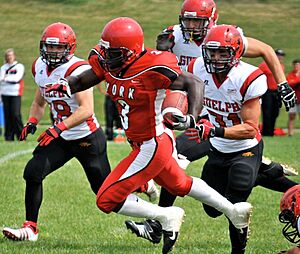
The university's sports teams are called the York Lions. Before 2003, they were known as the "Yeomen" and "Yeowomen." The name "Lions" was chosen to be simpler and more modern. The mascot is Yeo the Lion.
York offers 29 interuniversity sports teams. There are also 12 sport clubs and 35 intramural sport leagues. Students can join many daily pick-up sports activities.
York University has many sports facilities. These include a football stadium, gymnasiums, and playing fields. There are also tennis courts, squash courts, and ice arenas. The Aviva Centre hosts the Rogers Tennis Cup.
In 2014, the York Lions won four championships. These included men's national track and field and men's soccer titles. The women's tennis team won national championships in 2015 and 2016.
Fight Song
The "York Song" is often played at events like graduations and sports games. It is sung to the tune of "Harvard."
Fraternities and Sororities
York University does not officially recognize fraternities and sororities. However, Phi Delta Phi (ΦΔΦ), a legal fraternity at Osgoode Law School, is recognized. This is because it has been part of the law school since 1896.
Labour Discussions at York University
York University has had times when its faculty and teaching assistants have stopped working to ask for better conditions. These are called strikes.
In 1997, there was a strike by faculty that lasted seven weeks. In 2001, teaching assistants and contract faculty went on strike for 11 weeks. They were concerned about tuition rules.
Strikes in the 2000s and 2010s
A strike began on November 6, 2008. It was about job security for contract professors and other issues. On January 29, 2009, a law was passed to end the strike. It had lasted 85 days.
Another strike by teaching assistants and contract faculty happened in March 2015. Many classes were cancelled. The strike ended on March 31, 2015, after 29 days.
The longest university strike in Canadian history happened in 2018. It started on March 5, 2018. The union wanted better job security for contract faculty. The strike ended on July 25, 2018, after 143 days. A new law was passed to end it.
2024 Labour Discussions
Another strike by teaching assistants and contract faculty began on February 26, 2024. They wanted more job stability and higher wages. They also wanted pay increases to match inflation. A law from 2019 had limited public sector raises. This law was later found to be against union rights.
On April 14, 2024, the union and York University reached an agreement. The strike ended on April 19, 2024, after 53 days. Union members returned to work on April 22, 2024.
Notable People from York University
York University has over 370,000 living former students. Many live in Ontario, but many also live in other parts of Canada and around the world.
Distinguished Research Professors
The titles "distinguished research professor" and "university professor" are the highest honors for professors at York University. Only a small number of active professors can hold these titles. They are given to professors who have made amazing contributions to research.
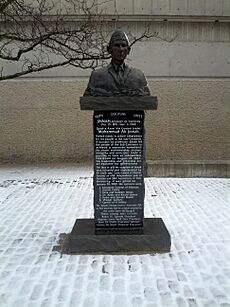
- Pat Armstrong, 2010: Sociology
- Isabella C. Bakker, 2014: Political Science
- Norbert Bartel, 2006: Physics & Astronomy
- Dawn Bazely, 2017: Biology
- Ellen Bialystok, 2003: Psychology
- Deborah Britzman, 2006: Education
- James Carley, 2000: English
- Jean-Gabriel Castel, 1986: Osgoode Hall Law School
- Jerome Ch'en, 1984: History
- Lorraine Code, 1998: Philosophy
- J. Douglas Crawford, 2013: Psychology
- Kenneth Davey, 1984: Biology
- Jonathan Edmondson, 2017: History
- Sheila Embleton, 2009: Languages, Literatures & Linguistics
- Stephen Gill, 2006: Political Science
- Jack Granatstein, 1994: History
- Leslie S. Greenberg, 2010: Psychology
- Philip Gulliver, 1985: Anthropology
- Henry S. Harris, 1984: Philosophy
- Robert Haynes, 1986: Biology
- Michael Herren, 1999: Humanities
- Eric Hessels, 2006: Physics & Astronomy
- Richard Hornsey , 2015: Electrical Engineering
- Ian Howard, 1988: Psychology
- Allan Hutchinson, 2006: Osgoode Hall Law School
- Christopher Innes, 1997: English
- Ian Jarvie, 1993: Philosophy
- Michael Kater, 1992: History
- Gabriel Kolko, 1986: History
- A. B. P. Lever, 1998: Chemistry
- Clifford Leznoff, 2003: Chemistry
- Paul Lovejoy, 1997: History
- John C. McConnell, 2005: Earth & Space Science & Engineering
- Gareth Morgan, 1992: Commerce
- H. V. Nelles, 2001: History
- Hiroshi Ono, 2001: Psychology
- Leo Panitch, 1999: Political Science
- Debra Pepler, 2008: Psychology
- Huw Pritchard, 1983: Chemistry
- David M. Regan, 1992: Psychology
- Marcia H. Rioux, 2013: Health Policy & Management
- R. Shayna Rosenbaum, 2025: Psychology
- Beryl Rowland, 1983: English
- Stuart Shanker, 2005: Psychology
- Gordon Shepherd, 1993: Earth & Space Science
- K. W. Michael Siu, 2008: Chemistry
- Brian Slattery, 2008: Osgoode Hall Law School
- Martin Steinbach, 2000: Psychology
- Bridget Stutchbury, 2009: Biology
- James Tenney, 1995: Music
- John Tsotsos, 2008: Computer Science & Engineering
- Leah Vosko, 2003: Political Science
- Jianhong Wu, 2011: Mathematics & Statistics
Chancellors of York University
- Wilfred Curtis, former Chief of the Air Staff of the Royal Canadian Air Force (1959 - 1968)
- Floyd Chalmers, publishing executive (1968 - 1973)
- Walter L. Gordon, former federal finance minister (1973 - 1977)
- John P. Robarts, former premier of Ontario (1977 - 1982)
- John S. Proctor, former bank executive (1982 - 1983)
- J. Tuzo Wilson, geophysicist (1983 - 1986)
- Larry Clarke, founder of SPAR Aerospace (1986 - 1991)
- Oscar Peterson, jazz pianist (1991 - 1994)
- Arden Haynes, former CEO of Imperial Oil (1994 - 1998)
- Avie Bennett, philanthropist (1998 - 2004)
- Peter deCarteret Cory, former justice of the Supreme Court of Canada (2004 - 2008)
- Roy McMurtry, former Chief Justice of Ontario (2008 - 2014)
- Gregory Sorbara, former Ontario cabinet minister (2014 – 2023)
- Kathleen Taylor, former chair of the Royal Bank of Canada (2023 – present)
Presidents of York University
- Murray G. Ross, academic 1959–1970
- David Slater, economist and civil servant 1970–1973
- H. Ian Macdonald, economist and civil servant 1973–1984
- Harry W. Arthurs, lawyer and academic 1985–1992
- Susan Mann, historian and academic, 1993–1997
- Lorna Marsden, academic and politician 1997–2007
- Mamdouh Shoukri, academic, 2007–2017
- Rhonda Lenton, academic (sociologist), 2017–present
See also
 In Spanish: Universidad York para niños
In Spanish: Universidad York para niños
- Allan I. Carswell Astronomical Observatory
- Canadian university scientific research organizations
- Education in Toronto
- Higher education in Ontario
- Las Nubes Rainforest Preserve
- List of universities in Ontario


